Culture, Nature, Social Enterprise at Rainforest World Music Festival 2016
Highlights of Rainforest World Music Festival 2016
From kiddy workshops, traditional crafts, spontaneous music workshops to energetic stage performances by international artistes - here are a few highlights of the one and only Rainforest World Music Festival 2016. By Mallika Naguran
Singapore 7 July 2016. The Rainforest World Music Festival (RWMF) brings together renowned world music artistes from around the world including indigenous musicians from the heart of Borneo. The all-day-long festival for all ages takes place this year from Friday 5 August to Sunday 7 August 2016 at the Sarawak Cultural Village, Santubong. Kuching, Sarawak.
The acclaimed Cimarron from Colombia will get you dancing with its rippling "joropo"!
This year’s acts include bands such as Shanren from China, Auli from Latvia, Torgeir Vassvik from Norway, Chouk Bwa Libete from Haiti, Cimarron from Colombia, Pat Thomas & Kwashibu Area Band from Ghana and many more.
A must watch gig would be Violons Barbares, which brings together a rare mix of traditions from Mongolia, Bulgaria and France. Look out for Dandarvaaching Enkhjargal on the morin khoor and jaw dropping overtone singing!
RWMF is most loved for its fun formula of interactive workshops, ethno-musical jamming sessions and mini concerts in the afternoon… prior to the actual show itself at night. To loyal fans of RWMF, the afternoon sessions are most entertaining, often making it the highlight of the festival itself.
Local and international food and drink can be purchased at the festival grounds. There will also be an arts and crafts area - get a temporary tattoo there! Buy festival memorabilia, Sarawak souvenirs and CDs by the performing artists.
Rare chance to hear rare voices and blends of traditions at RWMF, especially with Violons Barbares.
So yes, we are talking about festivity and feasts at the Sarawak Cultural Village from afternoon to past midnight. So bring lots of cash - Malaysian ringgit of course, although credit/debit cards may be accepted by certain merchants.
Something for Mom & Dad… and the Kids
There will also be fringe events to highlight Sarawak culture namely the Rainforest World Craft Bazaar and the Food and Village Mart, where one can purchase the local arts, crafts and cuisine of Borneo, as well as the Borneo Tattoo Expo at Damai Central, where one can see the traditional tribal tattoos of the indigenous tribes of Sarawak.
Look out for Pustaka Bookaroo, an event which combines music, stories and crafts from around the world for children aged between seven and 12.
RWMF Gets Bigger on Local Sounds
This year at the RWMF, eight Malaysian groups will share the stage with 26 international artistes.
Alena Murang sings as she plays the sape bringing the oral tradition of the Kenyah and Kelabit people from Ulu Baram alive.
Five artistes and groups from Sarawak will be featured, including sape maestros Alena Murang and Mathew Ngau Jau, Gendang Melayu Sri Buana, Thunder Beats of Nanyang Wushu Drums, as well as a performers from the Sarawak Cultural Village.
Two bands from Peninsular Malaysia, 1Drum.org and the Unique Arts Academy and the Band Girls of Sabah State Cultural Board will also take the stage.
“We are proud to provide a stage for our own talented performers to shine, showing that we too have leaders and groundbreakers in World Music as a genre.” says Angelina Patricia Bateman, Director of Corporate Communications, Sarawak Tourism Board and Project Director of the festival.
Local and international treats await you at this year's most unique Rainforest World Music Festival. Don't delay anymore - plan your trip today.
Visit the Official Website for more information: http://www.rwmf.net/
Visit RWMF Facebook
How to get your tickest for RWMF?
Nature Tribute at Rainforest World Music Festival 2015
Rainforest World Music Festival 2015 Brings Memories
Beto Jamaica Rey Vallenato in Rainforest World Music Festival
Review of Rainforest World Music Festival 2013
Mallika Naguran checks in to Sarawak to check out the region's popular world music festival.
Kuching, 1 July 2013. The 16th edition of the Rainforest World Music Festival (RWMF) in Santubong, Sarawak was a highlight in Asia's world music calendar. As before, the organisers Sarawak Tourism Board and artistic director Yeoh Jun Lin brought in mega international acts to perform alongside lesser known ones – striking varied rhythms to unleash vibrations of energy – from meditational low to fever pitch high. Festival-goers of nearly 20,000 over three days lapped it all up, 80 percent of which were mostly from West Malaysia and beyond, according to Angeline Bateman, communications director of Sarawak Tourism Board.
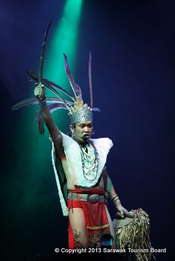
Sarawak native chanting for blessing

Dizu Plaatjies & The Ibuyambo Ensemble

Australian native gig Nunukul Yug
This year, RWMF 2013 showcased great acts from the corners of the world. Literally! Australian aboriginals Nunukul Yug; Ukrainian Spiritual Seasons; Habadekuk from Denmark; Kila from Ireland; Dizu Plaatjies & The Ibuyambo Ensemble; Kries from Croatia; Alp Bora from Turkey; Pine Leaf Boys from Lousiana; Chet Nuneta from France; Mohsen Sharifian & The Lian Band from Iran; Rey Vallenato Beto Jamaica from Colombia; and Palsandae from Korea.
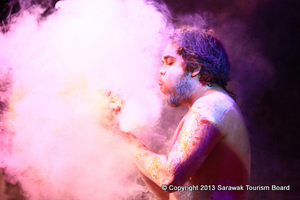
Nunukul Yug
On the home front were heritage showcases of culture set to music. The audience loved the local Borneo and Southeast Asian acts for their authenticity. From Sarawak, we had Maya Green, Gema SLDN-SCV, Lan E Tuyang (led by Matthew Ngau Jau) and Madeeh (featuring Arthur Borman “Bai Kas” Kanying). Malaysian Rhythm in Bronze gave uplifting gamelan and gong sounds, a pleasure to watch and listen to. Rafly Wa Saja crunched the spiritual nuances of Acehnese folk with groovy vocals using scat technique improvisation.
Australian aboriginals Nunukul Yuggera commanded attention with their narrative styled acts relating stories close to the heart of the people. There were adulations of dolphins for their role in saving mankind. There were calls made to the spirits for the protection of earth. There was a live demonstration of the art of making fire from sticks and hay. Yes, the way things used to be back in the good old days before the invasion of electric stoves and microwave ovens!
High-energy performances by Kila and Habadekuk stole the limelight, got audiences raving and dancing on their feet, while Colombians sent Latino-styled currents to the crowd but with authentic Cumbia and Vallenato performances. Alberto “Beto” Jamaica had a few years ago gotten a name for being the best accordionist in Bogota for Vallenato style music, pitting against 100 others to clinch the first position. Indeed, the Latino Vallenato folk compositions were among the highlights of the evening.
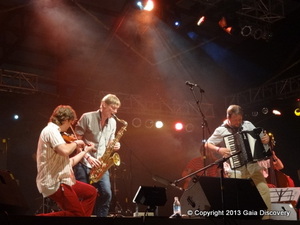
Habadekuk
While smoothly run most of the time, the festival programming seemed halting with Sarawakian performances coming on in between with bigger sounding acts. The music revelers that had their hands high and feet thumping before suddenly stood still to soak in meditational sequences and chants. From the programming perspective, this might have been deliberate, to try to inject some variety, alternating the pace for some relief. For some, it was time to visit the loo and grab the beer, passing over the rather pricey wine at RM18 for a puny glass.
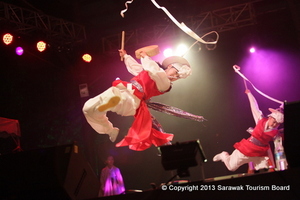
Korean Palsandae
Kries from Croatia was beautifully dark, haunting and gothic, but not quite the right band to slot in as the night’s anchor. Prior to it was Dizu Plaatjies & The Ibuyambo Ensemble - the pride of South Africans. Once again, as in most world music gigs, the Africans delivered! There were every minute mesmerizing, culturally engaging, danceable and melodioius with amazing vocal harmonies. The call to remember ailing Nelson Mandela, South Africa's first black President and all that he brought to South Africa was touching. After all what is world music if there aren’t any activist rejoinders?
But there’s only so much that one can write about music. To appreciate these musicians, you’ll have to buy their CDs and listen to their tracks. Hook up with their vids online, or watch this space for Gaia Discovery video posts. Better still, be there in Sarawak next year to enjoy some wonderful world music, actually among the best in this region, and that can only happen at the Rainforest!
Photography by Mallika Naguran and Sarawak Tourism Board.
Read Gaia Discovery's article on Chet Nuneta's reasons for singing in disappearing languages.
Rainforest World Music Festival 2012
14th Rainforest World Music Festival a Wonder
Rainforest World Music Festival 2011 Showcases Record 22 Performing Acts
Dance Workshops, Ancient Traditions and More to Feature in Rainforest World Music Festival 2010
Rainforest World Music Festival 2010 to Feature 20 International Artistes from 9-11 July
Gardon, Jouhikko, Nyckelharpa, Sape, Bamboo Pipes: World Music Celebration
Rainforest music festival highlights the sounds of cello-beating, hurdy gurdies and mouth organs.
By Michael Switow
SARAWAK, Malaysia — Nestled at the base of Mount Santubong, in a land made famous by the head-hunters, who only decades ago still fought here for honor, a Kenyah elder holds a dagger in his right hand and a hand-carved wooden shield in his left. He moves quickly, genuinely shocking his foe, a bare-chested Maori warrior, who moments earlier was intensely focused on the crowd in front of him.
Bats fly overhead.
Matthew Ngau is an artist and sculptor who rarely leaves his forested Borneo home and Te Hira Paenga is in training to become an Anglican minister, when he's not performing the Hakka and other traditional arts.
Only on the stage of the Rainforest World Music Festival is it likely that these two men would cross weapons. Cross-cultural surprises and jam sessions define this three-day festival, created 12 years ago to introduce Sarawakian musicians to the world and world musicians to Malaysia.
The festival also likely presents the world's best showcase of indigenous instruments.
“I'm looking to excite, amaze, enjoy, have a good time and also educate a little bit,” says artistic director and festival co-founder Randy Raine-Reusch. “This is a voyage of discovery for the audience. I want concert-goers to say `WOW, I've never seen that before!'”
The festival features an eclectic mix of bands including American country & bluegrass, East African drumming, Indonesian gamelan, Portuguese hard rock and Korean shamanistic tunes rarely heard outside traditional ceremonies. But every group has one common trait: each integrates indigenous instruments into its music. Some instruments have exotic names like the sumpoton, a free-reed mouth organ made with a calabash and bamboo pipes by villagers in northeast Borneo, or the hurdy gurdy, a European fiddle popular during the Renaissance which is played not with a bow but by cranking an attached wheel. Others like the Swedish nyckelharpa — an elongated fiddle with sixteen strings and an overlay of wooden pegs to control the pitch — are even more bizarre in appearance.
“These instruments are disappearing and I want that culture to survive,” explains Raine-Reusch, who plays hundreds of instruments as well. “I want to hear what that culture sounded like on the real thing. I'm not interested in hearing Balkan music on an electric guitar. I want to hear authenticity, even if it is in fusion music.”
Raine-Reusche estimates there are more than 5,000 instruments in the world — and that's if you don't count all the bells and rattles. Throw those into the mix and the count tops 10,000. At this year's Rainforest festival, 17 bands performed, yet only six used a guitar, well, seven if you count the one made from bamboo by Kinabalu Merdu Sound. Even fewer had a drum set.
Instead of drums, the Hungarian group Muszikas uses a gardon, an instrument that at first glance appears more suited to a string ensemble. The gardon player sets the tempo by hitting the instrument's strings with a stick. This “cello-beating” technique must have been tiring for traditional Hungarian musicians who earned their living by playing up to 40 hours non-stop at wedding parties.
This is not a festival of purists. Don't be fooled by the instruments. More than 20,000 music-lovers flock to the Sarawak Cultural Village each year for the Rainforest World Music Festival. Teenagers (and the not-so-young) dance for hours, but instead of partying to guitars, bass and drums, the mainstay of most pop bands, they jam to the sounds of the sapé, llimba and jouhikko.
(The sapé is a four-stringed instrument from Borneo whose lyrical melodies belie its cricket bat shape. llimba is an African thumb-piano, traditionally played by herders to mark their distance travelled. Jouhikko is a Finnish word, pronounced “yo-hee-ko”, for horsehair and Europe's oldest bowed instrument. )
“The tunes we are playing were really very cool two to three hundred years ago,” says jouhikko player Pekko Kappi. “We're still kind of shaking a little bit from how much fun we had,” says American musician Jeff Burke of the Jeff & Vida Band. “First of all, it's kind of packed here tonight, so there's a sea of people, in the middle of one of the most pristine areas that we've ever played a concert in. And the crowd here responds to what we do and music in general totally different than an American crowd would.”
Fans weaved a conga line through the crowd and sang along with every chorus, even though the tunes sung by Vida Wakeman in a raspy southern voice were original compositions they had never heard before.
“In the States, there's an etiquette, especially in bluegrass music” Burke explains. “ You sit quietly and listen and even if you love it and it's the best thing you've ever heard, you'll be quiet and when the song is over, you'll clap real loud and then stop really quickly so that the next song can happen, which always seemed nice until now, because it seems much more fun to have a crowd like this who kind of really throws themselves into the experience.”
Editors note: Visit our video section and picture gallery for more pictures and music from the event
Seeking Identities and Cultures in World Music
World Music Themes at Rainforest World Music Festival 2009
10 July 2009, Kuching.The sounds of World Music are intriguing backed by quaint strains of faraway bands playing with strange-looking musical instruments. What is more fascinating is the meaning behind the songs. We explore more into some of the stories and emotions that are carried in the songs performed at the 12th Rainforest World Music Festival held at the Sarawak Cultural Village.
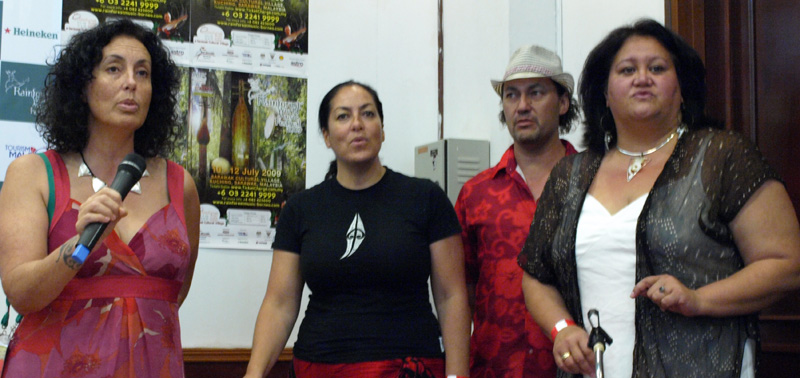
Moana & The Tribe from New Zealand.
For Moana & The Tribe, the Kiwis tell us that their songs are about spirituality, the environment and ancestors. “We see ourselves as guardians of the land and culture, the link between ancestors and the future,” says Moana the singer, composer and leader of the 12-piece band.
Her songs reflect the struggles faced by the Maoris.“Songs are a medium of storytelling; and we use songs to tell of the struggles of our tribes being marginalized.” She refers to the colonization of New Zealand were the Maori culture was chipped at and eroded.
A few songs question the state of things. One song, says Moana, urges “the keeping of traditional Maori names of mountains and rivers alive, formally and legally, not just within our people”. She spoke about the British renaming a mountain that was once called Aoraki to Mt Cook. Aoraki is the highest mountain in New Zealand at 3,754m in the Southern Alps.
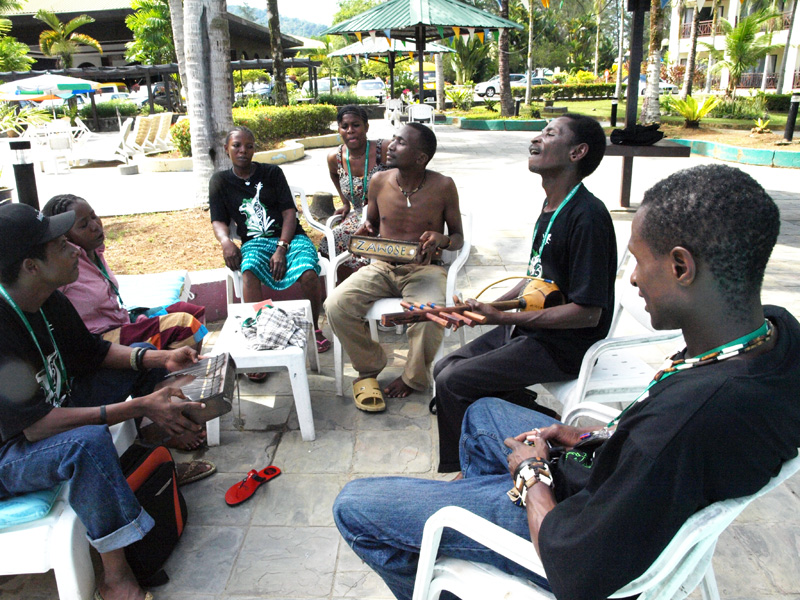
The Zawose family rehearsing poolside.
The song “Moko” addresses the difference between moko (Maori tattoo) and contemporary tattoo, to drive home the point that there is meaning in every indigenous moko carved on the skin of the Maoris. This is not to be dealt with flippantly or misused.
Vasco from Dazkarieh says his music unravels the differentways people relate to each other. He hopes to take a new approach in forging the relations between people. Some songs are about working in the field, and some religious. The Portuguese band revives songs played well before an oppressive Portugal regime 40 yrs ago that banned ethnic music.
The Zawose Family sings in Kigogo, their native dialect in Tanzania, retaining the old flavours of the African country before Swahili was nationalized as a unifying language. The late Hukwe Zawose composed songs that stirred the hearts of the people in taking pride in their country.

Robert Zawose
“We sing about the land, about nature, about people coming together, about life,” smiles Robert Zawose, then points to the tree. “See as we sing, even birds are coming.”
Even while keeping to age-old rhythm, listeners can appreciate their songs about the sufferings involved in the Hiroshima bombing as well as HIV disease. “Sumbu” is about how a woman feels when her child has lost her way, then is struck with memories of her difficult childbirth.
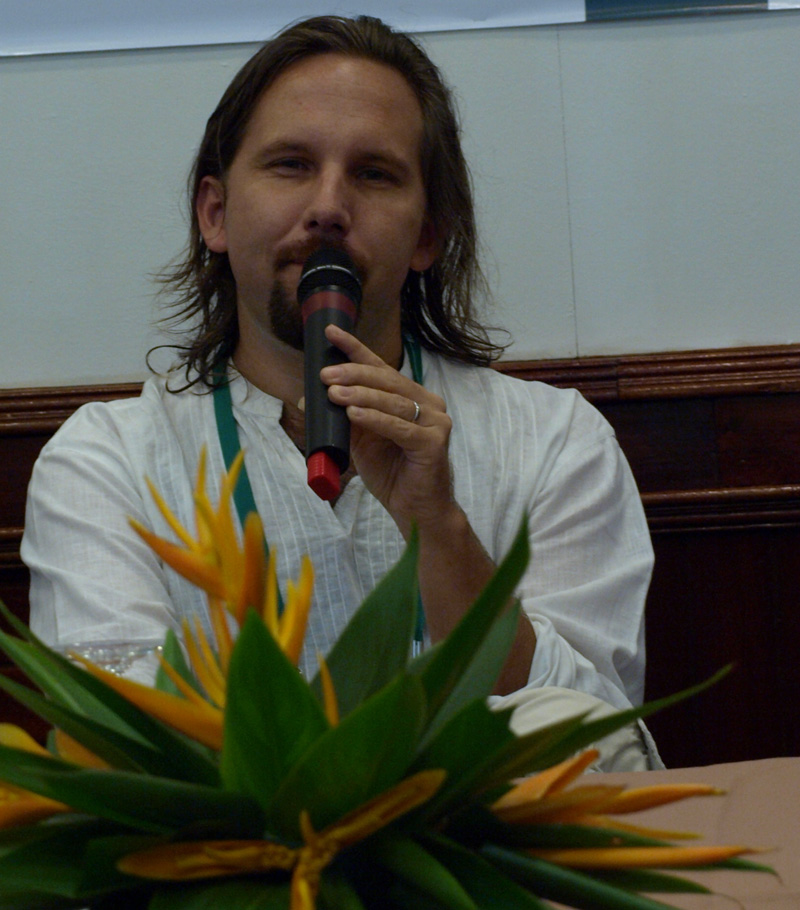
Akasha's James
Akasha from cosmopolitan Malaysia is a “rojak” instrumental band with skills in world music, classical and Latin Jazz. It becomes more interesting when the players who are ethnically Indians, Chinese and Caucasian playtraditional Malay music like the joget, and more contemporary tunes like blues, funk, jazz and Latin.
Guitarist James thinks music need not always have a story or a meaning. “Music has the effect of bringing out a story within people when they listen to it. It pretty much lies in the eye of the beholder; it's not limited by our own vision of it.”
Photos by Mallika Naguran.
See related articles on Gaia Discovery: Interview with festival director Randy Raine-Reusch on 2009 surprising finds; challenges faced by Sarawak Tourism Board before the opening of the 12th Rainforest World Music Festival.
Rainforest World Music Festival Puts Sarawak on the Map
Spirits Soar at Sarawak Rainforest World Music
by Mallika Naguran
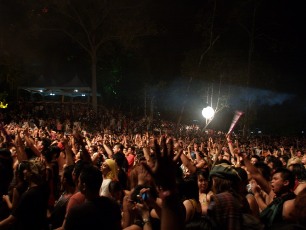
What’s a Rainforest Festival without some rain?
That’s the attitude that got half the audience up on their feet, grooving at the 11th Sarawak Rainforest World Music Festival 2008. Squelching ankle-deep mud could not stop them, while the rest – families, locals, foreigners from around the world – picnicked on sheets and mats on drier grounds, enjoying the party atmosphere from afar.
After all, this was the time they had waited oh so impatiently to be at Sarawak where the magic of music uncurls. Torrential rain on the opening day after ten consecutive years of great weather marked a first; in fact, organizers considered it bad timing. It was very, very, very wet.
However, musician Jean Claude from Kasai Masai was of the mind that it was auspicious. “If you don’t mind, I will tell you that in Congo where we come from originally, it rains everyday. This is because of the equatorial rainforest which is a lot bigger that Sarawak’s. Let me tell you that we, performing here for the first time, have brought our rainforest spirit with us. It is no coincidence.”
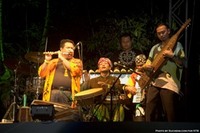
Tuku Kame of Sarawak.
It is hardly coincidental that the event brought together diverse spirits and cultures to produce colliding sound waves.
Foreign bands, 12 of them, and five local groups, oozed non-stop wide-ranging sounds such as traditional, folk, fusion, Celtic, rock, Baul and Socca.
The performers were New Rope String Band (United Kingdom), Yakande (Gambia/Guinea), Pinikpikan (The Philippines), Adel Salameh (Palestine), Ross Daly Quartet (Greece), Fadomorse (Portugal), Kasai Masai (Congo), Hiroshi Motofuji (Japan), Oikyataan (India), Beltaine (Poland), Sheldon Blackman and The Love Circle (Trinidad & Tobago).
Malaysian bands were Akasha, Anak Jati Bisaya Orchestra, Kan’id, Senida and Tuku Kame.
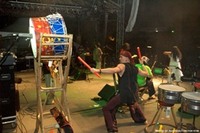
Pinikpikan thumps through hearts.
Appreciating the spirit of the community, environment, even the wild, form part of Pinikpikan’s life values. Guitarist and group director Samy of Pinikpikan talked about whales being poached and killed, and his song Butan Ding renders this point. “It’s a huge beast, yet it is vegetarian, eating plankton. So why kill it?” he asked.
The eight-member band from The Philippines spread the message of whale protection with traditional musical instruments such as the tungatong (bamboo shaker), derbuka (drum) and kutyati (two-stringed instrument from Mindanao) with Western instruments through an eclectic mix such as Afro-Cuban, Arabic and Asian.
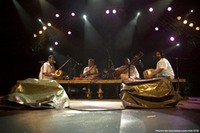
Hendrix reinvented with Akasha.
They were among the youngster favourites who also included Akasha (Malaysia), Beltaine, Kasai Masai and Sidney
Sheldon over the three-day concert from 11-13 July at Sarawak Cultural Village in Santubong. Taiko drummer Hiroshi Motofuji put on a pounding performance with a spread of drums, including the Indian mridhangam with mastery of interpretation.
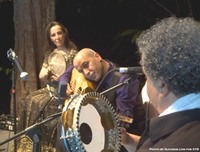
Adel Salameh trio thrill.
Oud player Adel Salameh’s finger work held me in awe, accompanied by wild honey vocalist Naziha Azzouz, an Algerian. I especially enjoyed watching their unassuming drummer play expertly on the tambourine in the opening solo – a simple instrument we often take for granted – yet capable of soaring the spirit.
Photos by Foto Polo Singapore (www.travel-Malaysia.com) and Suchens.com for Sawarak Tourism Board.
Make plans now to attend the 12th Sarawak Rainforest Music Festival on 10-12 July 2009. Fringe events being planned in town, plus spend time at the world craft bazaar and folk art forum. Hotels get full during the event, so make plans early. And while you are in Sarawak, visit their many eco destinations.
Coming soon: recommended eco destinations in Kuching and Sarawak.


